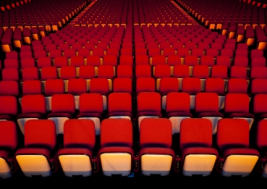
Apparently it’s been a bad summer for box office sales. In fact, not such a great decade or two, with attendance and ticket sales fluctuating in a slow but steady downward trend. Clamours of extinction come as no surprise in the face of an inexorable shift towards “on demand” content consumption, where consumers can watch what they want when they want. Movie theaters are thus faced with a classic content and container problem.
- A lack of diversity and risk-taking on movie screens
A large part of the industry is tailored to a movie theatre distribution model fueled by blockbusters with massive production budgets and star power, intended to draw crowds and sales. Two issues arise from this:
- Action franchises and sequels dominate theater screens, and while many are highly successful, banking on a “sure thing” becomes repetitive – a formula that loses steam when diverse and quality content is easily within reach through other sources.
- Series are disrupting and conquering viewership with edgy storylines that mainstream movies rarely touch and production quality rivaling Hollywood, and entire seasons available on a variety of sources (Binge-watching? Game of Thrones? No… you don’t do that.)
- An old-fashioned container?
Consumers are eager for good, stimulating content and movies per se are not in immediate danger of losing their “entertainer” role. However the theater no longer provides a premium or unique venue for this experience.
- Theaters’ operating format contrasts sharply with the “instant access” trend: limited selection, specific show times and location, and comparatively high ticket price.
- Detractors consider the home viewing experience comparable or superior, with access to more choices for less money through a plethora of sources (VOD, Netflix, streaming or downloading, etc.) now connected to ever larger and higher resolution screens and more powerful sound systems.
In the short-term, the industry plans to offer movie-goers a more luxurious, complete experience (in the vein of D-box), while other ideas include a shared database of movies for smaller theaters, digital laser projection, a real time voting app where viewers choose movies, etc.
This being said, people are still going to the movies.
I still go, though less often than 10 years ago, as I too have succumbed to Netflix with open arms. The “dark room” still holds the promise of magic and transformation. It is a sanctuary where I can disconnect from the “real world” and immerse myself in the images and sounds washing over me. At home, the thrill is lost. The ritual isn’t the same. And the sound of ripping open a bag of chips doesn’t count (ketchup, if you must know).But do not consider me unwilling to change – I am eagerly awaiting Star Trek holodecks.
What about you? How do you see the future of movie theaters?

